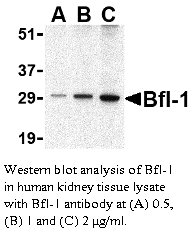Anti-Human Bfl-1 (CT)
Data
- -
- -
Antibody DetailsProduct DetailsReactive Species Human Host Species Rabbit Immunogen PN:B484 Product Concentration 0.5 mg/ml Formulation This polyclonal antibody is formulated in phosphate buffered saline (PBS) pH 7.4 containing 0.02% sodium azide as a preservative. Storage and Handling This polyclonal antibody is stable for at least one week when stored at 2-8°C. For long term storage, aliquot in working volumes without diluting and store at –20°C in a manual defrost freezer. Avoid Repeated Freeze Thaw Cycles. Country of Origin USA Shipping Next Day Ambient RRIDAB_2828211 Each investigator should determine their own optimal working dilution for specific applications. See directions on lot specific datasheets, as information may periodically change. DescriptionDescriptionSpecificity Rabbit Anti-Human Bfl-1 recognizes an epitope near the C-terminus of human and mouse Bfl-1. This polyclonal antibody was purified using affinity chromatography. Background Apoptosis plays a major role in normal organism development, tissue homeostasis, and removal of damaged cells and is caused by caspase activation. Proteins that comprise the Bcl-2 family appear to control the activation of these enzymes. One such member is multi-domain antiapoptotic protein Bfl-1, which is overexpressed in stomach and other cancers. Bfl-1 can interact with Bax and suppress apoptosis by inhibiting the release of cytochrome c and caspase-3 activation. It is upregulated in cisplatin-resistant human bladder tumor, suggesting that its expression may be important for cisplatin resistance and inhibition of apoptosis in cancer cells. At least two isoforms of Bfl-1 are known to exist. Presumably due to post-translational modifications, Bfl-1 is often observed at higher molecular weight in SDS-PAGE than its predicted molecular weight would suggest. PubMed References & Citations1. Lockshin, RA. et al. (2000) Cell Death Differ. 7:2-7. 2. Choi, SS. et al. (1995) Oncogene 11:1693-8. 3. Kim, JK. et al. (2004) Cancer Lett. 212:61-70. 4. Zhang, H. et al. (2000) J. Biol. Chem. 275:11092-9 Technical ProtocolsCertificate of Analysis |
Related Products
- -
- -
Prod No. | Description |
|---|---|
B453 | |
B484 | |
B485 |



